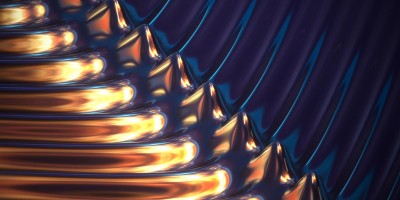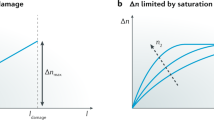Abstract
The size and operating energy of a nonlinear optical device are fundamentally constrained by the weakness of the nonlinear optical response of common materials1. Here, we report that a 50-nm-thick optical metasurface made of optical dipole antennas coupled to an epsilon-near-zero material exhibits a broadband (∼400 nm bandwidth) and ultrafast (recovery time less than 1 ps) intensity-dependent refractive index n2 as large as −3.73 ± 0.56 cm2 GW−1. Furthermore, the metasurface exhibits a maximum optically induced refractive index change of ±2.5 over a spectral range of ∼200 nm. The inclusion of low-Q nanoantennas on an epsilon-near-zero thin film not only allows the design of a metasurface with an unprecedentedly large nonlinear optical response, but also offers the flexibility to tailor the sign of the response. Our technique removes a longstanding obstacle in nonlinear optics: the lack of materials with an ultrafast nonlinear contribution to refractive index on the order of unity. It consequently offers the possibility to design low-power nonlinear nano-optical devices with orders-of-magnitude smaller footprints.



Similar content being viewed by others
References
Alam, M. Z., De Leon, I. & Boyd, R. W. Large optical nonlinearity of indium tin oxide in its epsilon-near-zero region. Science 352, 795–797 (2016).
Miller, D. A. B. Are optical transistors the logical next step? Nat. Photon. 4, 3–5 (2010).
Sherwood-Droz, N. et al. Optical 4×4 hitless silicon router for optical networks-on-chip (NoC). Opt. Express 16, 15915–15922 (2008).
Boyd, R. W., Gehr, R. J., Fischer, G. L. & SipeJ. Nonlinear optical properties of nanocomposite materials. J. Eur. Opt. Soc. A 5, 505–512 (1996).
Boyd, R. W. & Sipe, J. E. Nonlinear optical susceptibilities of layered composite materials. J. Opt. Soc. Am. B 11, 297–303 (1994).
Sarychev, A. K. & Shalaev, V. M. Electromagnetic field fluctuations and optical nonlinearities in metal-dielectric composites. Phys. Rep. 335, 275–371 (2000).
Abb, M., Albella, P., Aizpurua, J. & Muskens, O. L. All-optical control of a single plasmonic nanoantenna–ITO hybrid. Nano Lett. 11, 2457–2463 (2011).
Abb, M., Wang, Y., de Groot, C. H. & Muskens, O. L. Hotspot-mediated ultrafast nonlinear control of multifrequency plasmonic nanoantennas. Nat. Commun. 5, 4869 (2014).
Lee, J. et al. Giant nonlinear response from plasmonic metasurfaces coupled to intersubband transitions. Nature 511, 65–69 (2014).
Yang, Y. et al. Nonlinear Fano-resonant dielectric metasurfaces. Nano Lett. 15, 7388–7393 (2015).
Minovich, A. E. et al. Functional and nonlinear optical metasurfaces. Laser Photon-. Rev. 9, 195–213 (2015).
Ren, M. et al. Nanostructured plasmonic medium for terahertz bandwidth all-optical switching. Adv. Mater. 23, 5540–5544 (2011).
Liberal, I., Mahmoud, A. M., Li, Y., Edwards, B. & Engheta, N. Photonic doping of epsilon-near-zero media. Science 355, 1058–1062 (2017).
Engheta, N. Pursuing near-zero response. Science 340, 286–287 (2013).
Edwards, B., Alù, A., Young, M. E., Silveirinha, M. & Engheta, N. Experimental verification of epsilon-near-zero metamaterial coupling and energy squeezing using a microwave waveguide. Phys. Rev. Lett. 100, 033903 (2008).
Alù, A., Silveirinha, M. G., Salandrino, A. & Engheta, N. Epsilon-near-zero metamaterials and electromagnetic sources: tailoring the radiation phase pattern. Phys. Rev. B 75, 155410 (2007).
Silveirinha, M. & Engheta, N. Tunneling of electromagnetic energy through subwavelength channels and bends using ε-near-zero materials. Phys. Rev. Lett. 97, 157403 (2006).
Caspani, L. et al. Enhanced nonlinear refractive index in ε-near-zero materials. Phys. Rev. Lett. 116, 233901 (2016).
Neira, A. D. et al. Eliminating material constraints for nonlinearity with plasmonic metamaterials. Nat. Commun. 6, 7757 (2015).
Capretti, A., Wang, Y., Engheta, N. & Dal Negro, L. Enhanced third-harmonic generation in Si-compatible epsilon-near-zero indium tin oxide nanolayers. Opt. Lett. 40, 1500–1503 (2015).
Luk, T. S. et al. Enhanced third harmonic generation from the epsilon-near-zero modes of ultrathin films. Appl. Phys. Lett. 106, 151103 (2015).
Yu, N. et al. Light propagation with phase discontinuities: generalized laws of reflection and refraction. Science 334, 333–337 (2011).
Ni, X., Emani, N. K. Kildishev, A. V., Boltasseva, A. & Shalaev, V. M. Broadband light bending with plasmonic nanoantennas. Science 335, 1214686 (2012).
Kildishev, A. V., Boltasseva, A. & Shalaev, V. M. Planar photonics with metasurfaces. Science 339, 1232009 (2013).
Yu, N. & Capasso, F. Flat optics with designer metasurfaces. Nat. Mater. 13, 139–150 (2014).
High, A. A. et al. Visible-frequency hyperbolic metasurface. Nature 522, 192–196 (2015).
Lin, D., Fan, P., Hasman, E. & Brongersma, M. L. Dielectric gradient metasurface optical elements. Science 345, 298–302 (2014).
Chong, K. E. et al. Polarization-independent silicon metadevices for efficient optical wavefront control. Nano Lett. 15, 5369–5374 (2015).
Vassant, S. et al. Epsilon-near-zero mode for active optoelectronic devices. Phys. Rev. Lett. 109, 237401 (2012).
Campione, S., Brener, I. & Marquier, F. Theory of epsilon-near-zero modes in ultrathin films. Phys. Rev. B 91, 121408 (2015).
Campione, S., Wendt, J. R., Keeler, G. A. & Luk, T. S. Near-infrared strong coupling between metamaterials and epsilon-near-zero modes in degenerately doped semiconductor nanolayers. ACS Photon-. 3, 293–297 (2016).
Schulz, S. A. et al. Optical response of dipole antennas on an epsilon-near-zero substrate. Phys. Rev. A 93, 063846 (2016).
Sheik-Bahae, M., Said, A. A., Wei, T.-H., Hagan, D. J. & Van Stryland, E. W. Sensitive measurement of optical nonlinearities using a single beam. IEEE J. Quantum Electron. 26, 760–769 (1990).
Luk, T. S. et al. Directional perfect absorption using deep subwavelength low-permittivity films. Phys. Rev. B 90, 085411 (2014).
Khurgin, J. B., Sun, G., Chen, W. T., Tsai, W.-Y. & Tsai, D. P. Ultrafast thermal nonlinearity. Sci. Rep. 5, 17899, https://doi.org/10.1038/srep17899 (2015).
Sachet, E. et al. Dysprosium-doped cadmium oxide as a gateway material for mid-infrared plasmonics. Nat. Mater. 14, 414–420 (2015).
Kim, J. et al. Role of epsilon-near-zero substrates in the optical response of plasmonic antennas. Optica 3, 339–346 (2016).
Hadad, Y., Sounas, D. & Alu, A. Space–time gradient metasurfaces. Phys. Rev. B 92, 100304 (2015).
Yu, Z. & Fan, S. Complete optical isolation created by indirect interband photonic transitions. Nat. Photon-. 3, 91–94 (2009).
Staude, I. et al. Tailoring directional scattering through magnetic and electric resonances in subwavelength silicon nanodisks. ACS Nano 7, 7824–7832 (2013).
Kuznetsov, A. I., Miroshnichenko, A. E., Brongersma, M. L., Kivshar, Y. S. & Luk’yanchuk, B. Optically resonant dielectric nanostructures. Science 354, aag2472 (2016).
Boyd, R. W. Nonlinear Optics (Academic Press, Cambridge, MA, 2003).
Campione, S., Kim, I., de Ceglia, D., Keeler, G. A. & Luk, T. S. Experimental verification of epsilon-near-zero plasmon polariton modes in degenerately doped semiconductor nanolayers. Opt. Express 24, 18782–18789 (2016).
Liu, X. et al. Quantification and impact of nonparabolicity of the conduction band of indium tin oxide on its plasmonic properties. Appl. Phys. Lett. 105, 181117 (2014).
Kane, E. O. Band structure of indium antimonide. J. Phys. Chem. Solids 1, 249–261 (1957).
Schulz, S. A. et al. Quantifying the impact of proximity error correction on plasmonic metasurfaces [invited]. Opt. Mater. Express 5, 2798–2803 (2015).
Bezanson, J., Edelman, A., Karpinski, S. & Shah, V. B. Julia: a fresh approach to numerical computing. SIAM Rev. 59, 65–98 (2017).
Acknowledgements
The authors acknowledge support from the Canada Excellence Research Chairs Program, the Natural Sciences and Engineering Research Council of Canada (NSERC), and the Canada Foundation for Innovation (CFI). I.D.L. acknowledges financial support from CONACyT (Ciencia Básica) grant no. 286150. M.Z.A. thanks S. Choudhary for discussions on the linewidth broadening mechanisms in a plasmonic system.
Author information
Authors and Affiliations
Contributions
I.D.L. conceived the idea and initiated the study. I.D.L., S.A.S., M.Z.A. and J.U. designed the sample. S.A.S. performed the FDTD simulations. S.A.S. and J.U. fabricated the sample. M.Z.A. performed all experiments and the corresponding data analysis, developed the numerical model to describe the nonlinear response, and wrote the first draft. All authors contributed to finalizing the manuscript. I.D.L. and R.W.B. supervised the project.
Corresponding author
Ethics declarations
Competing interests
R.W.B. is the co-founder and Chief Technology Officer of KBN Optics, Pittsford NY.
Additional information
Publisher’s note: Springer Nature remains neutral with regard to jurisdictional claims in published maps and institutional affiliations.
Supplementary information
Supplementary Information
Supporting theory and data; Supplementary Figures 1–10; Supplementary Table 1.
Rights and permissions
About this article
Cite this article
Alam, M.Z., Schulz, S.A., Upham, J. et al. Large optical nonlinearity of nanoantennas coupled to an epsilon-near-zero material. Nature Photon 12, 79–83 (2018). https://doi.org/10.1038/s41566-017-0089-9
Received:
Accepted:
Published:
Issue Date:
DOI: https://doi.org/10.1038/s41566-017-0089-9
- Springer Nature Limited
This article is cited by
-
Thermo-optic epsilon-near-zero effects
Nature Communications (2024)
-
Annealing-free fabrication of high-quality indium tin oxide films for free-carrier-based hybrid metal–semiconductor nanophotonics
Scientific Reports (2023)
-
All optical modulation in vertically coupled indium tin oxide ring resonator employing epsilon near zero state
Scientific Reports (2023)
-
Tunable Nonlinear Meta-Absorber Based on Epsilon-Near-Zero Metamaterial
Journal of Russian Laser Research (2023)
-
Ultracompact Nanophotonics: Light Emission and Manipulation with Metasurfaces
Nanoscale Research Letters (2022)





